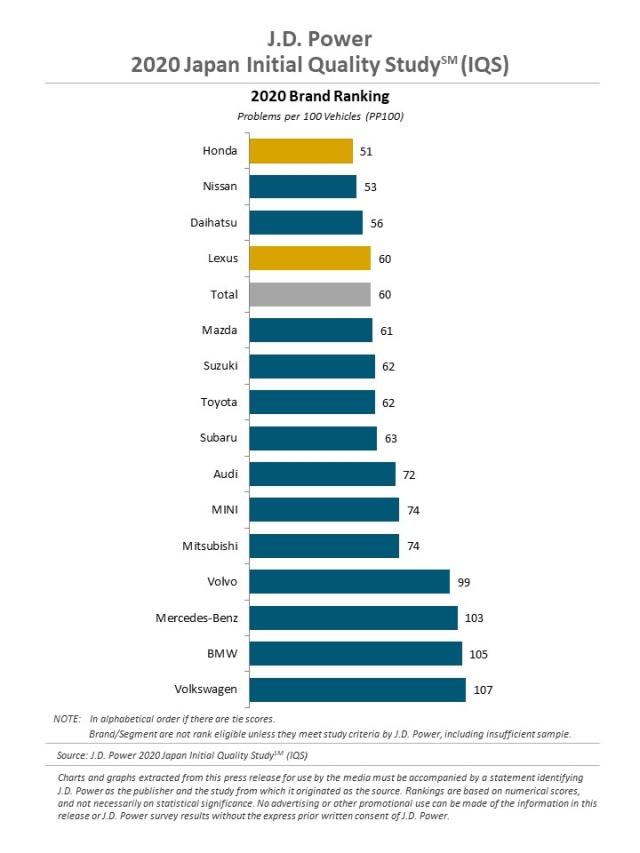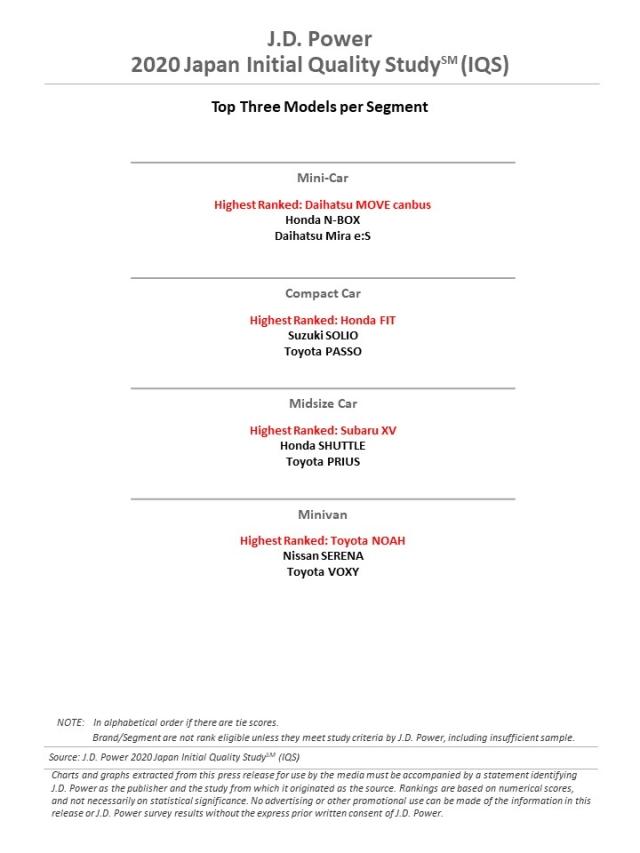Vehicle Initial Quality in Japan Has Steadily Improved, but Satisfaction Remains Stagnant, J.D. Power Finds
Honda Ranks Highest for Initial Quality for First Time
TOKYO: 19 Aug. 2020 — While new-vehicle owners report fewer problems overall with their new vehicle this year and initial vehicle quality has further improved, more problems are reported in two areas than in previous years, according to the J.D. Power 2020 Japan Initial Quality StudySM (IQS), released today.
“Initial vehicle quality in Japan has clearly improved due to efforts by every automobile manufacturer,” said Koichi Urayama, senior director of the automotive division at J.D. Power. “Despite those efforts, however, there’s still work to be done because customer satisfaction has not increased since 2014. It is critical that manufacturers find ways to decrease the number of reported problems with safety features and the advanced technology-related functions. Both of these areas represent emerging quality issues, and such improvements will not only increase initial quality satisfaction among current owners but also among those who switch from other brands. Presenting the market with solutions to these challenges will be the first step toward a competitive advantage strategy.”
The study, now in its 10th year, examines problems experienced by owners of new 2020 model-year vehicles during the first 90 days of ownership. Initial quality is determined by the number of problems experienced per 100 vehicles (PP100), with a lower score reflecting higher quality.
Following are some key findings of the 2020 study:
- The fewest number of problems are reported since the study’s redesign in 2014: Initial quality in 2020 averages 60 PP100. This is 24 PP100 fewer than in 2014 (84 PP100), the first year the study was redesigned, and 6 PP100 fewer than 2019 (66 PP100).
- The largest improvement is in the engine/transmission category: Since 2014, the largest improvement has been in the engine/transmission category, a decrease of 6.6 PP100, followed by the vehicle interior category with a decrease of 5.4 PP100. In particular, owners have reported fewer problems for AT/CVT hesitating or shifting at wrong times; difficult to use cup holders; and unpleasant interior odors.
- More problems are reported for safety features and advanced technology-related functions: Since 2014, problems have been more frequently reported for built-in Bluetooth mobile phone/device having frequent pairing or connectivity issues; built-in voice recognition not recognizing or misinterpreting commands; and lane departure warning systems (lane keeping assist) - difficult to understand, use, or poorly arranged switches or indicators. Increasingly, new vehicles are equipped with these features and functions, which is the reason for a higher number of problems reported in these areas.
- Improvement in initial quality differs depending on brand: The largest improvements year over year are seen for MINI and Volvo among import brands and for Mazda among domestic brands. MINI has a decrease of 69 PP100, followed by Volvo (-56 PP100) and Mazda (-45 PP100).
- The number of reported problems differs depending on the purchaser’s past experience; those who switch from other brands report a higher number of problems:Initial quality among purchasers who bought their new vehicle as a replacement or an addition from the same brand as their previous vehicle is 58 PP100 and averages 67 PP100 among switchers from other brands, a difference of 9 PP100. This suggests that switchers are likely to provide poorer evaluations for initial vehicle quality. This trend is more marked for luxury brands than mass market brands (mainly domestic brands).
- Although the number of reported problems in 2020 has decreased, overall customer satisfaction has not improved: Overall customer satisfaction in 2020 remains essentially unchanged from 2014, with an average of 7.68 (on a 10-point scale) in 2020 compared to an average of 7.66 points in 2014, which indicates that the improvement in initial quality has not contributed to an increase in customer satisfaction.
Highest-Ranked Brands
Honda ranks highest in overall initial quality for the first time since the study’s inception. Lexus ranks highest in the luxury segment for a second consecutive year.
Segment-Leading Models
- Mini-Car segment: Daihatsu MOVE canbus
- Compact Car segment: Honda FIT
- Midsize Car segment: Subaru XV
- Minivan segment: Toyota NOAH
The 2020 Japan Initial Quality Study is based on responses from 19,435 purchasers of new vehicles in the first two to nine months of ownership. The online survey was fielded from May through June 2020.
The study, now in its tenth year, measures new-vehicle quality in the first two to nine months of ownership. Vehicle quality is evaluated by owners across 233 problem areas in eight categories: vehicle exterior; driving experience; features/controls/displays (FCD); audio/communication/entertainment/navigation (ACEN); seats; heating, ventilation and air conditioning (HVAC); vehicle interior; and engine/transmission.
About J.D. Power and Advertising/Promotional Rules www.jdpower.com/business/about-us/press-release-info

